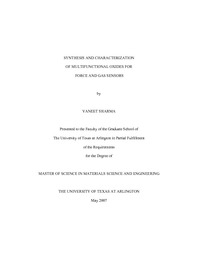
ATTENTION: The works hosted here are being migrated to a new repository that will consolidate resources, improve discoverability, and better show UTA's research impact on the global community. We will update authors as the migration progresses. Please see MavMatrix for more information.
Show simple item record
| dc.contributor.author | Sharma, Vaneet | en_US |
| dc.date.accessioned | 2007-08-23T01:56:24Z | |
| dc.date.available | 2007-08-23T01:56:24Z | |
| dc.date.issued | 2007-08-23T01:56:24Z | |
| dc.date.submitted | December 2006 | en_US |
| dc.identifier.other | DISS-1608 | en_US |
| dc.identifier.uri | http://hdl.handle.net/10106/270 | |
| dc.description.abstract | In this research work, the piezoresistivity phenomena in multifunctional oxides of La0.8Sr0.2MnO3 (LSMO) and composites of LSMO - (Ce0.12Zr0.88)O2 has been investigated for force and gas sensor applications in harsh environments including automobile and aerospace industry. In these applications, there is a need of material with high mechanical strength with multi sensing capabilities. The inherent sensing capabilities allow the material to be implemented at variety of platforms.
Previously, LSMO polycrystalline ceramics have been studied as a cathode material in solid oxide fuel cells (SOFC). Owing to its colossal magnetoresistance properties, this material has also been extensively studied for use in magnetic read heads and magnetic memory devices. Significant research has been conducted to further improve the magnetoresistive properties of this material by using doping elements. This research invokes some of the results from these prior studies. Recently, the piezoresistivity phenomenon in LSMO has been reported. In this research, this property has been investigated in details and various strategies have been adapted to improve its magnitude including the effect of doping elements.
Trivalent Bi3+ and univalent Li+ ions were selected as dopants for substitution on La-site while pentavalent Nb5+ and divalent Cu2+ ions were selected for substitution on Mn-site. The effect of doping concentration on piezoresistivity, electrical properties, magnetic properties and microstructure was characterized. Doped compositions showed improvement in the piezoresistive coefficient as compared to the pure LSMO. The Li doped ceramics were found to exhibit -1.0% change in electrical resistivity, 4mol% Bi and 6mol% Bi modified compositions showed change of of -1.8 and -2.4% respectively at 19.2MPa uniaxial stress. The change in resistivity was found to be in the opposite direction to that of the pure LSMO. The Cu2+ ions in low concentration range of 2mol% did not show any significant enhancement in the piezoresistive properties of LSMO. The Nb5+ ions were found to have a remarkable effect on piezoresistive property of LSMO¬. A giant increase in piezoresistivity was observed for 5mol% Nb modified LSMO with the total change in electrical resistivity of +3.0% at 19.2MPa uniaxial stress.
Nb-modified LSMO was selected as the force sensor material. In order to improve the mechanical strength of this material a composite of ceria stabilized zirconia and Nb-LSMO was synthesized. The mechanical characteristics and piezoresistive properties of the composite were studied. The results showed unstable resistive behavior under stress for the composite material. A miniature force sensor prototype for demonstrating the force sensing capability of the Nb modified composition was designed, fabricated and characterized. The sensor exhibited maximum output voltage response of 4mVdc at applied force of 480 N.
Next, the synthesis conditions of the LSMO - ceria - zirconia composites was optimized to achieve a nanoporous network in order to make this material suitable for oxygen gas sensor. The approach was based upon the strain assisted self assembly achieved through monoclinic - tetragonal phase transformation. The average diameter of the pores was found to be in the range of 150 - 200nm. The pore distribution was quite periodic with an average spacing between pores around 50 -150 nm. This nanoporous surface network was found to exist only on the surface of the material and the porous layer was found to be around 100nm thick. This material was used to design an oxygen sensor. The sensor data was not very encouraging due to poor oxygen ion conduction. | en_US |
| dc.description.sponsorship | Priya, Shashank | en_US |
| dc.language.iso | EN | en_US |
| dc.publisher | Materials Science & Engineering | en_US |
| dc.title | Synthesis And Characterization Of Multifunctional Oxides For Force And Gas Sensors | en_US |
| dc.type | M.S.Mat.S.E. | en_US |
| dc.contributor.committeeChair | Priya, Shashank | en_US |
| dc.degree.department | Materials Science & Engineering | en_US |
| dc.degree.discipline | Materials Science & Engineering | en_US |
| dc.degree.grantor | University of Texas at Arlington | en_US |
| dc.degree.level | masters | en_US |
| dc.degree.name | M.S.Mat.S.E. | en_US |
Files in this item
- Name:
- umi-uta-1608.pdf
- Size:
- 14.75Mb
- Format:
- PDF
This item appears in the following Collection(s)
Show simple item record


